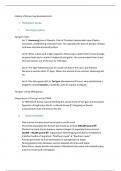History of Korea: key developments
1. Prehistoric Korea
I. The Origin myth(s)
Tan’gun myth:
Act 1: Hwanung (son of Hwanin, God of Creation) descended upon Paektu
mountain, establishing a Sacred Town. He regulated the lives of people, healed
sickness and administered justice.
Act 2: When a bear and a tiger prayed to Hwanung to make them human beings,
he gave them each a stalk of mugword and garlic. He commanded them to eat
this and remain out of the sun for 100 days.
Act 3: The tiger failed because he could not stay in the cave, but the bear
became a woman after 21 days. When she wished to be married, Hwanung did
so.
Act 4: She then gave birth to Tan’gun (Sandalwood Prince), who established a
kingdom named Chosŏn in 2333 BC, with its capital at Asadal.
Tan’gun vs Kija (Wikipedia)
Mausoleum of Tan’gun in the DPRK
- In 1993 North-Korea reported finding the actual tomb of Tan’gun and his queen
- Question of legitimacy North- vs South-Korea (P’yŏngyang vs Seoul)
- A mausoleum was erected on the site
II. Early Inhabitants
- Few human remains were found due to acidic soils
- Hominids populated the Korean peninsula by at least 200,000 years BP
- Modern humans (homo sapiens sapiens) began to populate Korea around
30,000 – 40,000 years BP, replacing or intermingling with earlier inhabitants
- 2 distinct paths of migration: “Northern route” & “Southern route”
- Korean peninsula as final destination or springboard to Japan
- Strong genetic links between ancient peoples of Korea and Japan
- Early Korea, Japan and the mainland of Northeast Asia were not isolated areas,
cultures mixed and overlapped
, III. The Paleolithic Era (c. 200,000 BP – 8000 BP/6000 BCE)
- Use of stone tools: large rough tools to smaller and more elaborated ones such
as choppers, hand axes, borers to make holes and tangs to a long rod to attack
animals
- Hunting, gathering
- Nomadic life in small bands, setting up temporary camps or living for brief
periods in caves
- Warming climate (end of last ice age) brought about changes in the mode of
human life and marked the beginning of a transition to the Neolithic Period
Kŏmŭnmoru Cave: discovered in 1966; excavated in 1968-70
IV. The Neolithic Era (c. 8000 BCE – 2000 BCE)
- Pottery with raised or stamped decoration (tŏnmunŭi t’ogi): incised decoration,
typified by “comb pattern” pottery (chŭlmun t’ogi)
- Similarity in pottery styles suggests that early inhabitants of Korea were part of a
larger complex of Northeast-Asian peoples and cultures; distinctiveness in the
pottery of Korea?
- Shell art depicting human faces, fishing hooks
- Settled life began (earth-pit houses)
- “Neolithic Revolution”: transition from hunting fishing and gathering to
agriculture (millet and rice; slash-and-burn farming; stone axes, hoes
and ttabi = plow-like tool) and animal husbandry as the basis of subsistence
Comb-pa8erned po8ery
Raised decora7on po8ery (chǔlmun t’ogi 櫛文土器 )
(tŏnmunǔi t’ogi 덧덧덧土器 ) excavated at Amsa-dong (Seoul) 선선 선선선 선선 岩寺洞遺蹟
excavated at Yŏngsŏn-dong (Pusan) 釜山 瀛仙洞
,V. The Beginning of the Bronze Age (c. 2000 BCE – 300 BCE)
- First evidence of bronze artifacts in Korea: 13th c. BCE; first bronze wares and
later bronze technology arrived from Northern China
- Plain pottery style or undecorated pottery style (mumun t’ogi)
- Dolmens (koindol)
o “table-type” (t’akcha) = Northern type
o “go-board-type” (paduk) = Southern type
o “capstone-type” = all over Korea
à suggests social stratification
3 types of dolmen
“table-type” “go-board-type” “capstone-type”
Northern Korea Southern Korea All over Korea
, 2. Old Chosŏn, the Hàn commanderies & the Samhan confederations (7th c.
BCE – early 4th c. CE)
I. Old Chosŏn (7th c. BCE – 108 BCE)
- According to legend, Tan’gun (Sandalwood Prince) established Chosŏn in 2333
BC, with its capital at Asadal
Etymology:
- “Old Chosŏn” (Kojosŏn) to avoid confusion with Chosŏn Dynasty (1392-1910)
- 2 periods: Early Period (7th -4th c. BCE) and Later Period (300-108 BCE) (map)
- “Chosŏn” first mentioned in Guǎnzi, attributed to Gua ̌ n Zhòng, edited in 26 BCE
- cháo: “dawn” or “morning” / xiān: “fresh” or “calm”
- comes from geographic position of Korea relative to China
- today refers to the Chosŏn dynasty or DPRK, while South-Korea is called Hanguk




